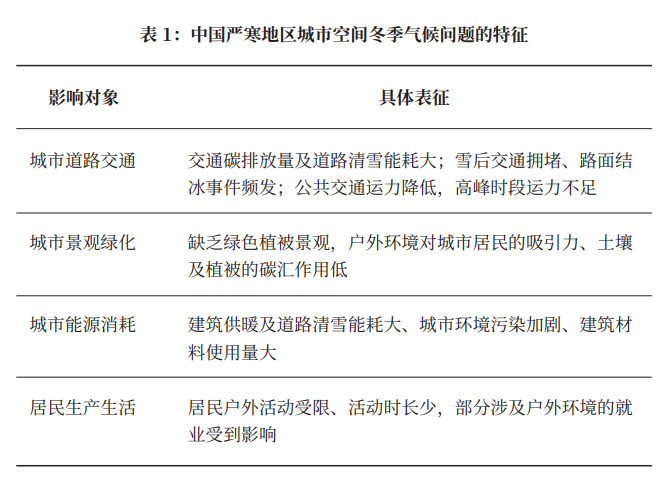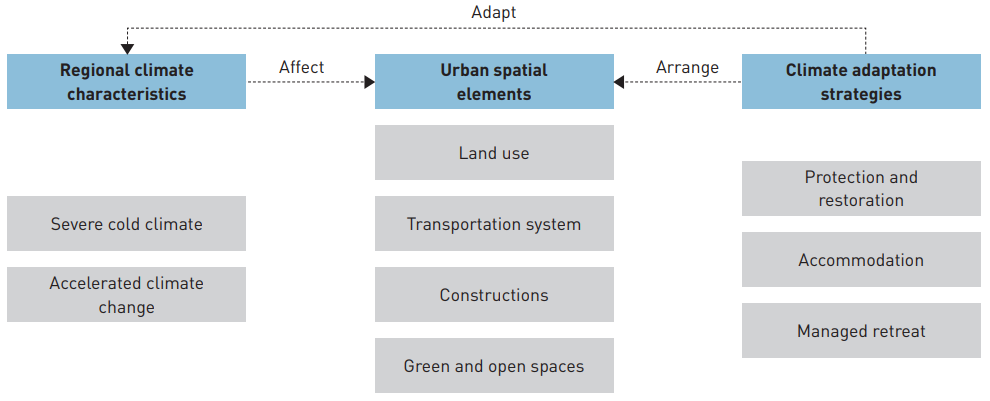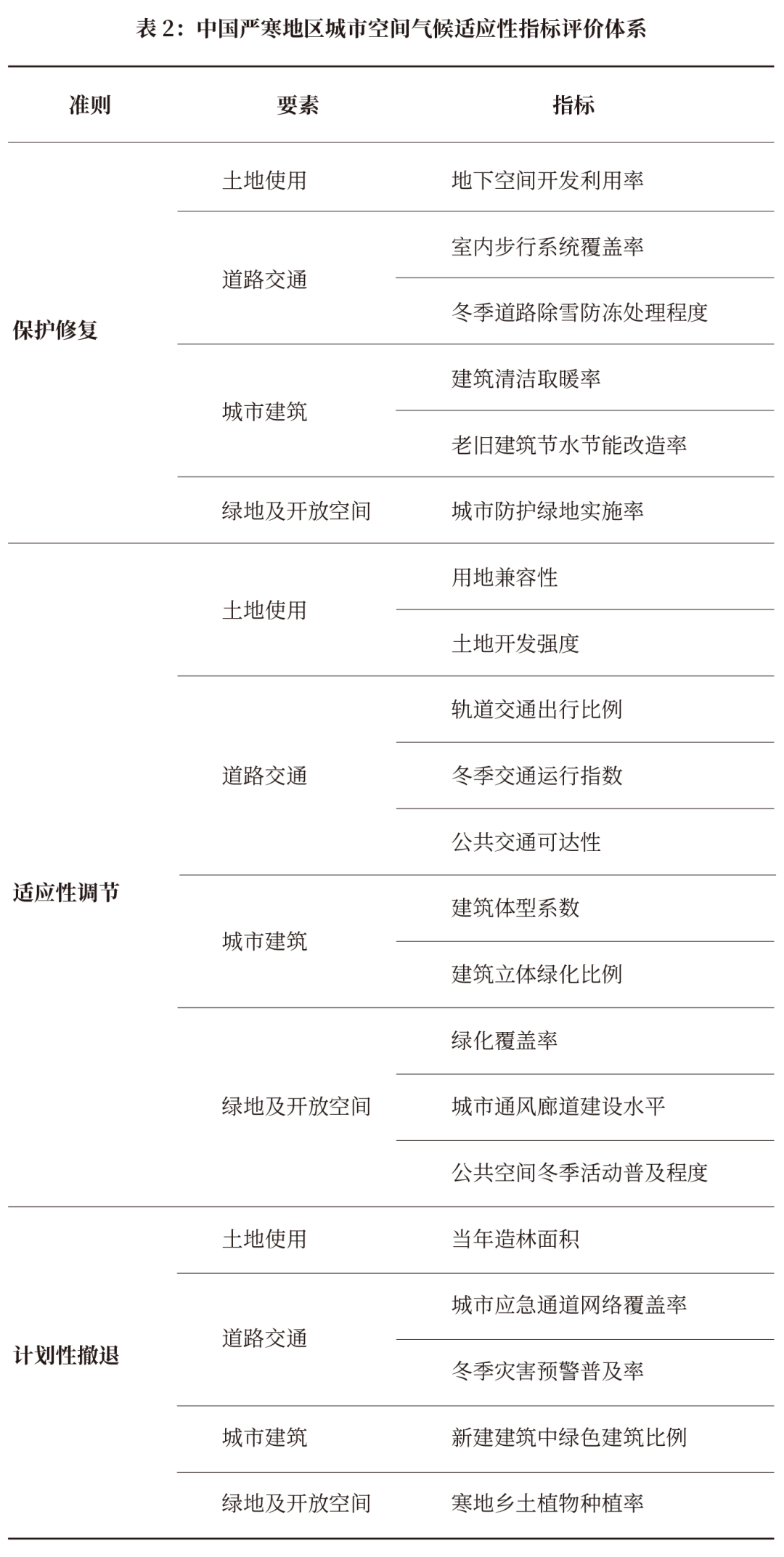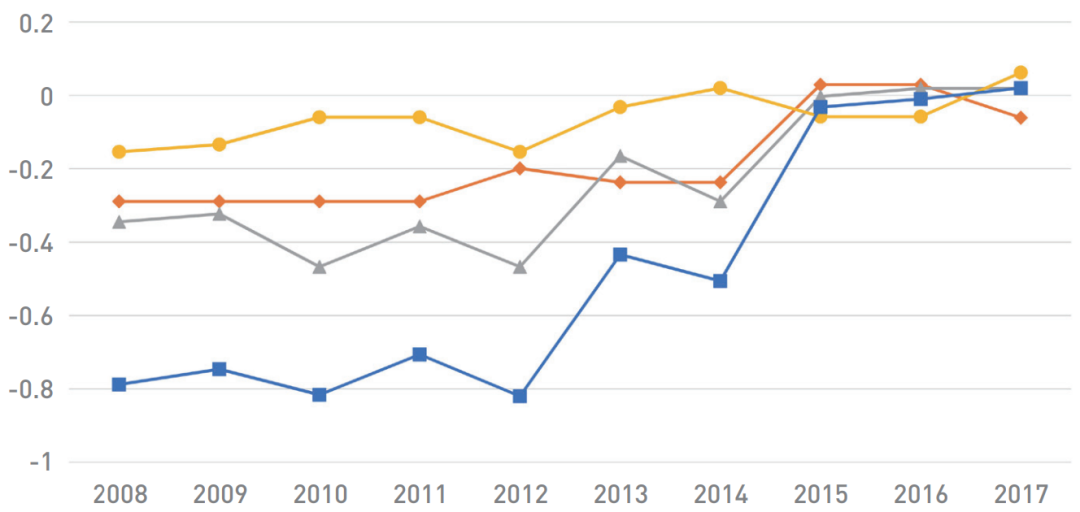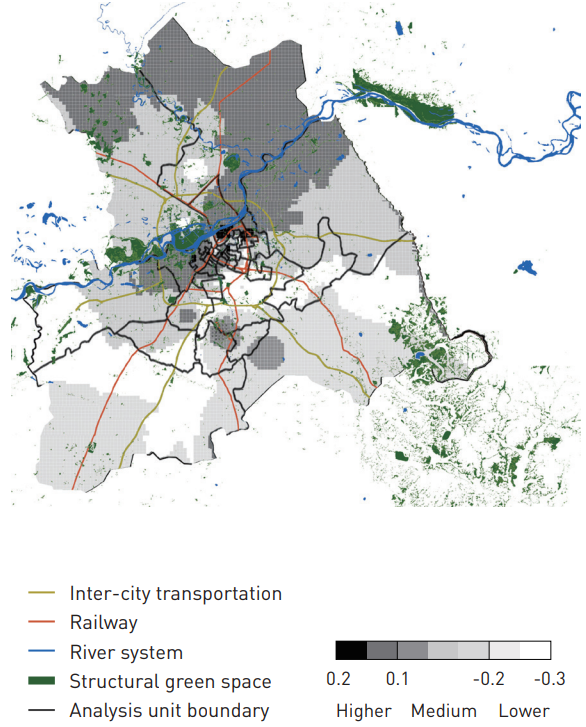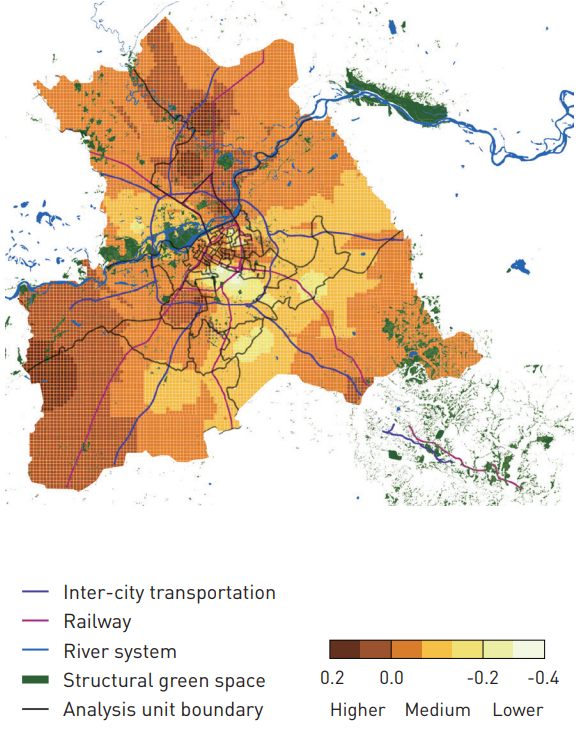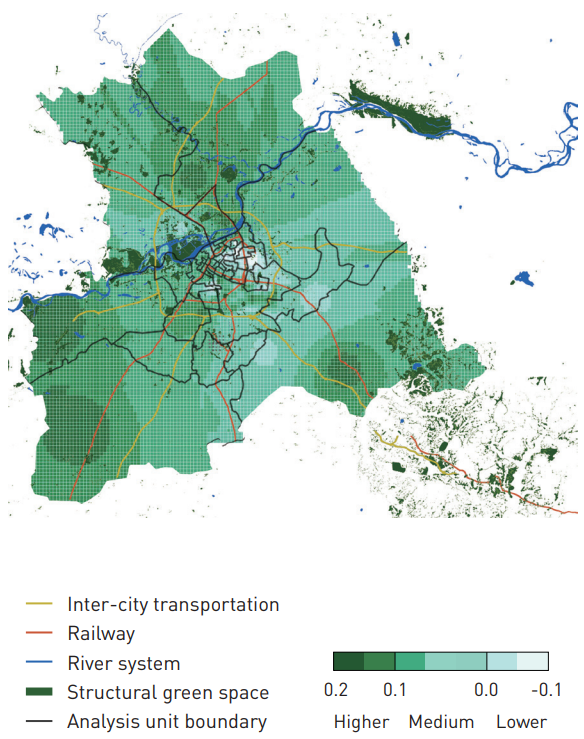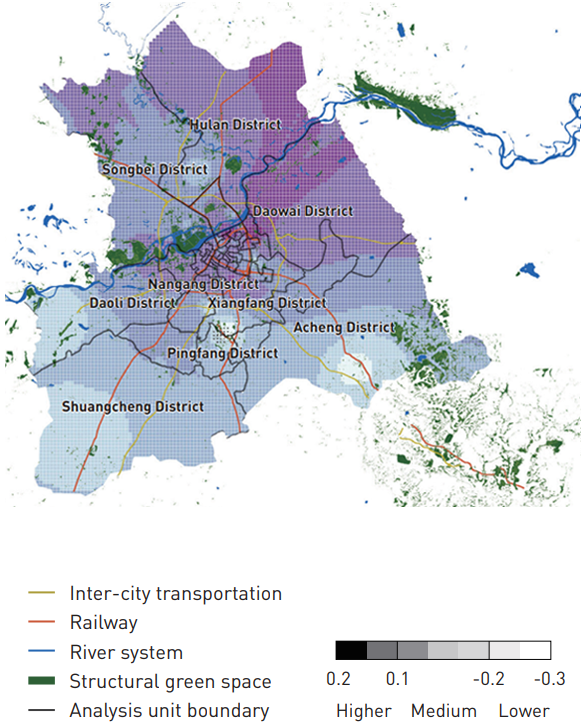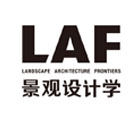本文構(gòu)建了中國(guó)嚴(yán)寒地區(qū)城市空間的氣候適應(yīng)性評(píng)價(jià)指標(biāo)體系�,并以哈爾濱中心城區(qū)為例進(jìn)行氣候適應(yīng)性的時(shí)空分異評(píng)價(jià)�。
氣候適應(yīng)性研究應(yīng)該同時(shí)涵蓋氣候變化與地域氣候背景兩方面因素�����。從城市空間角度進(jìn)行氣候適應(yīng)性的研究并對(duì)其展開(kāi)評(píng)價(jià)�,有助于明確城市空間建設(shè)在應(yīng)對(duì)氣候問(wèn)題方面的薄弱環(huán)節(jié)。本文構(gòu)建了中國(guó)嚴(yán)寒地區(qū)城市空間的氣候適應(yīng)性評(píng)價(jià)指標(biāo)體系�����,并以哈爾濱中心城區(qū)為例進(jìn)行氣候適應(yīng)性的時(shí)空分異評(píng)價(jià)。結(jié)果表明����,研究區(qū)域城市空間的綜合氣候適應(yīng)性能力在2008~2017年間基本呈提升趨勢(shì),但總體仍處于較低水平��,同時(shí)各市轄區(qū)的氣候適應(yīng)性存在較為顯著的空間差異和要素發(fā)展不均衡現(xiàn)象��。本研究將為未來(lái)中國(guó)開(kāi)展嚴(yán)寒地域氣候背景下的國(guó)土空間規(guī)劃體系編制�����、氣候適應(yīng)性專項(xiàng)規(guī)劃研究等提供一定的參考��,進(jìn)而推動(dòng)中國(guó)嚴(yán)寒地區(qū)城市的氣候適應(yīng)性建設(shè)��,也對(duì)中國(guó)正在開(kāi)展的氣候適應(yīng)型城市建設(shè)試點(diǎn)工作具有積極的借鑒意義�。
關(guān)鍵詞
嚴(yán)寒地區(qū);城市空間��;氣候適應(yīng)性�;評(píng)價(jià)指標(biāo)體系;適應(yīng)策略
中國(guó)嚴(yán)寒地區(qū)城市空間的氣候適應(yīng)性評(píng)價(jià)指標(biāo)體系構(gòu)建研究
——以哈爾濱市中心城區(qū)為例
Construction of Climate Adaptability Evaluation Indicator System for Urban Spaces in the Severe Cold Zones of China—A Case Study on the Central Area of Harbin
1 哈爾濱工業(yè)大學(xué)建筑學(xué)院
2 哈爾濱工業(yè)大學(xué)寒地國(guó)土空間規(guī)劃與生態(tài)保護(hù)修復(fù)重點(diǎn)實(shí)驗(yàn)室
由于氣候系統(tǒng)的慣性�����,氣候變化將帶來(lái)持久的影響�。為此����,政府間氣候變化專門(mén)委員會(huì)(IPCC)指出,在未來(lái)的一段時(shí)間內(nèi)����,應(yīng)將氣候適應(yīng)作為應(yīng)對(duì)氣候變化的重要手段����,且城市屬于實(shí)行氣候適應(yīng)措施的重要作用區(qū)域。
界定和評(píng)價(jià)不同城市的氣候適應(yīng)性是城市開(kāi)展適應(yīng)性規(guī)劃和決策制定的基礎(chǔ)��。近年來(lái)��,相關(guān)領(lǐng)域?qū)W者主要通過(guò)兩種途徑對(duì)城市氣候適應(yīng)性進(jìn)行評(píng)價(jià)研究:1)評(píng)價(jià)氣候適應(yīng)行動(dòng)方案�;2)評(píng)估城市空間要素與氣候要素的相互作用。第一種途徑關(guān)注政府部門(mén)主導(dǎo)的氣候適應(yīng)行動(dòng)���,重在評(píng)價(jià)行動(dòng)的經(jīng)濟(jì)和生態(tài)效益����,目前已成為國(guó)內(nèi)外氣候適應(yīng)性規(guī)劃體系主流做法的一部分;第二種途徑主要衡量城市空間要素能否以及如何適應(yīng)不斷加劇的氣候變化����。然而,目前國(guó)內(nèi)外從城市空間視角展開(kāi)系統(tǒng)性氣候適應(yīng)性評(píng)價(jià)的研究仍十分有限����,且尚未建立針對(duì)城市空間的氣候適應(yīng)性評(píng)價(jià)體系。
城市氣象學(xué)家蒂姆·奧克(Tim Oke)認(rèn)為����,不同地域所遭受的氣候變化影響存在較大差別,因此氣候適應(yīng)性研究應(yīng)同時(shí)涵蓋氣候變化與地域氣候兩方面因素���。目前����,國(guó)內(nèi)外應(yīng)對(duì)氣候變化的城市空間規(guī)劃研究日趨增多�����,然而基于地域氣候背景探究氣候適應(yīng)性規(guī)劃應(yīng)對(duì)機(jī)制的研究十分有限����,以地域氣候適應(yīng)為切入點(diǎn)展開(kāi)的相關(guān)研究幾近空白。立足地域氣候背景評(píng)價(jià)城市空間的氣候適應(yīng)性�,有助于明確城市空間建設(shè)在應(yīng)對(duì)氣候問(wèn)題方面的薄弱環(huán)節(jié)�。
本文旨在構(gòu)建中國(guó)嚴(yán)寒地區(qū)(即累年最冷月平均溫度不高于-10°C的地區(qū))城市空間的氣候適應(yīng)性評(píng)價(jià)指標(biāo)體系���,并以典型嚴(yán)寒地區(qū)城市哈爾濱的中心城區(qū)為例�,針對(duì)評(píng)價(jià)結(jié)果提出相關(guān)對(duì)策,以期為未來(lái)中國(guó)嚴(yán)寒地區(qū)城市制定氣候適應(yīng)性規(guī)劃和建設(shè)決策提供支撐。
中國(guó)嚴(yán)寒地區(qū)城市空間的氣候適應(yīng)性
研究團(tuán)隊(duì)總結(jié)了基于嚴(yán)寒氣候與氣候變化背景的城市空間氣候問(wèn)題的特殊性,并據(jù)此解析嚴(yán)寒地區(qū)城市空間氣候適應(yīng)性的內(nèi)涵,進(jìn)而提出了嚴(yán)寒地區(qū)城市空間應(yīng)對(duì)氣候問(wèn)題的途徑。
城市規(guī)劃的核心內(nèi)容之一是對(duì)城市物質(zhì)空間要素(如土地利用、道路交通����、城市建筑和綠地及開(kāi)放空間)進(jìn)行布局�,而合理的布局與設(shè)計(jì)可以增強(qiáng)城市對(duì)氣候問(wèn)題的適應(yīng)能力�。因此,從城市空間的角度研究氣候適應(yīng)性規(guī)劃���,是氣候適應(yīng)與城市規(guī)劃的重要結(jié)合點(diǎn)���。
IPCC將應(yīng)對(duì)氣候變化和極端天氣事件的適應(yīng)策略分為三類:保護(hù)(protection)、適應(yīng)性調(diào)節(jié)(accommodation)和計(jì)劃性撤退(managed retreat)���。立足地域氣候與氣候變化的雙重背景,本文將這三類適應(yīng)策略的應(yīng)用場(chǎng)景在城市空間層面進(jìn)行了延伸,界定了嚴(yán)寒地區(qū)城市空間的三類氣候適應(yīng)性途徑���,即保護(hù)修復(fù)��、適應(yīng)性調(diào)節(jié)����、計(jì)劃性撤退�。
嚴(yán)寒地區(qū)城市空間的氣候問(wèn)題特征�、城市空間要素與氣候適應(yīng)性途徑的相互作用關(guān)系 ? 蔣存妍���,冷紅��,袁青
1)保護(hù)修復(fù)���。采取工程措施保護(hù)城市內(nèi)易受影響的城市空間,保障重要的社會(huì)服務(wù)和居民基本的生產(chǎn)生活�����。此外����,還需要修復(fù)已經(jīng)受到影響的空間��,通過(guò)干預(yù)措施將其調(diào)整為外界干擾脅迫之前的城市系統(tǒng)狀態(tài)�。在本研究中��,這類途徑主要包括對(duì)城市能源消耗量大的交通��、建筑產(chǎn)業(yè)進(jìn)行節(jié)能修復(fù)�;對(duì)易受冬季嚴(yán)寒氣候影響的城市系統(tǒng)進(jìn)行氣候防護(hù)或保護(hù)等。
2)適應(yīng)性調(diào)節(jié)����。當(dāng)氣候變化趨勢(shì)加劇但負(fù)面影響較輕時(shí),依靠城市系統(tǒng)自身的韌性或自適應(yīng)機(jī)制而不另外施加適應(yīng)措施�,就能有效調(diào)節(jié)氣候變化所帶來(lái)的影響,實(shí)現(xiàn)城市的照常運(yùn)轉(zhuǎn)�。在本研究中,這類途徑主要包括重點(diǎn)保障冬季城市交通的運(yùn)行效率��,增加綠地及開(kāi)放空間以提升土壤及植被的碳匯和微氣候調(diào)節(jié)功能等���。
3)計(jì)劃性撤退����。當(dāng)受到的脅迫超過(guò)自適應(yīng)與人為適應(yīng)能力之和時(shí)����,應(yīng)對(duì)氣候脆弱性或風(fēng)險(xiǎn)性較大的城市空間進(jìn)行撤退,以減少氣候問(wèn)題所帶來(lái)的負(fù)面影響��。在本研究中�,這類途徑主要包括冬季氣候?yàn)?zāi)害發(fā)生時(shí)城市的預(yù)警及應(yīng)急處理,以及為應(yīng)對(duì)不利的冬季氣候影響而進(jìn)行的城市系統(tǒng)轉(zhuǎn)型(如植被置換)等�����。
中國(guó)嚴(yán)寒地區(qū)城市空間氣候適應(yīng)性評(píng)價(jià)指標(biāo)體系的建立
本文基于文獻(xiàn)研究——參考世界其他嚴(yán)寒地區(qū)城市空間與氣候環(huán)境相關(guān)性研究成果��、發(fā)達(dá)國(guó)家寒地城市氣候調(diào)節(jié)政策���,同時(shí)借鑒城市氣候承載力����、氣候變化脆弱性等評(píng)價(jià)指標(biāo)體系的構(gòu)建過(guò)程——并綜合考慮數(shù)據(jù)的可獲得性��,通過(guò)相關(guān)類目合并��、系列相關(guān)剔除等步驟��,最終確定了21項(xiàng)評(píng)價(jià)指標(biāo)。
根據(jù)各項(xiàng)評(píng)價(jià)指標(biāo)的不同屬性��,通過(guò)以下三種途徑為各指標(biāo)賦值�。
1)若評(píng)價(jià)指標(biāo)在規(guī)劃、法律條令�����、管理規(guī)定中已有明確的定義和計(jì)算方式����,則據(jù)此方式計(jì)算獲取指標(biāo)的數(shù)值。
2)對(duì)于自身沒(méi)有明確定義和計(jì)算方式�、但可獲取相似指標(biāo)明確量化要求的評(píng)價(jià)指標(biāo),依據(jù)相似指標(biāo)推斷該指標(biāo)的參考值��。
3)對(duì)于暫無(wú)明確計(jì)算方式的指標(biāo)(即定性指標(biāo))���,依據(jù)指標(biāo)內(nèi)涵或橫向比較年度指標(biāo)值的方式�,將指標(biāo)賦值劃分為三個(gè)等級(jí)(如低-中-高���、不全面-中等-全面)����。
由于本評(píng)價(jià)體系中同時(shí)包含定性及定量指標(biāo),構(gòu)成具有一定的復(fù)雜性�,因此采用主客觀綜合集成賦權(quán)法確定評(píng)價(jià)指標(biāo)的權(quán)重。研究將權(quán)重值高于平均水平的指標(biāo)確定為嚴(yán)寒地區(qū)城市空間氣候適應(yīng)性主因子�����,共8項(xiàng)——室內(nèi)步行系統(tǒng)覆蓋率����、建筑清潔取暖率�、用地兼容性、軌道交通出行比例����、冬季交通運(yùn)行指數(shù)、綠化覆蓋率��、城市通風(fēng)廊道建設(shè)水平�,以及城市應(yīng)急通道網(wǎng)絡(luò)覆蓋率。
哈爾濱城市空間氣候適應(yīng)性動(dòng)態(tài)分析
依托中國(guó)嚴(yán)寒地區(qū)城市空間氣候適應(yīng)性評(píng)價(jià)指標(biāo)體系��,本研究選取典型嚴(yán)寒地區(qū)城市哈爾濱�,并以其中心城區(qū)為研究對(duì)象,基于相關(guān)統(tǒng)計(jì)及空間數(shù)據(jù)���,對(duì)研究區(qū)域城市空間開(kāi)展氣候適應(yīng)性評(píng)價(jià)��。
哈爾濱地處中國(guó)東北平原東北部����,是東北地區(qū)的交通、政治�����、經(jīng)濟(jì)��、文化�����、金融中心�,同時(shí)也是中國(guó)緯度最高、冬季氣溫最低的特大城市�。哈爾濱的中心城區(qū)范圍涵蓋南崗區(qū)、道里區(qū)��、香坊區(qū)���、道外區(qū)���、平房區(qū)��、松北區(qū)的全部��,以及呼蘭區(qū)�、雙城區(qū)�����、阿城區(qū)的部分區(qū)域��,總面積約4187km2��。
哈爾濱中心城區(qū)城市空間的氣候適應(yīng)性動(dòng)態(tài)變化 ? 蔣存妍���,冷紅,袁青
在此期間��,隨著國(guó)家及地方相關(guān)政策陸續(xù)出臺(tái)��,城市社會(huì)經(jīng)濟(jì)穩(wěn)步發(fā)展��;相關(guān)部門(mén)逐步意識(shí)到增強(qiáng)城市空間氣候適應(yīng)性的重要性,并在城市建設(shè)的各方面采取了積極的應(yīng)對(duì)措施����,對(duì)生態(tài)環(huán)境治理的投入也有所增加。相應(yīng)地�,研究區(qū)域城市空間的3項(xiàng)氣候適應(yīng)性能力和綜合氣候適應(yīng)性能力基本呈現(xiàn)上升的趨勢(shì)。然而����,研究年份內(nèi),研究區(qū)域的交通出行及工業(yè)企業(yè)建筑能源消耗量大���、城市空間形態(tài)不緊湊��、綠地碳匯系統(tǒng)薄弱等問(wèn)題均較為突出�����,三項(xiàng)氣候適應(yīng)性能力和綜合氣候適應(yīng)性能力的分值都較低��。與此同時(shí)�,綜合氣候適應(yīng)性能力的得分也呈現(xiàn)出較大波動(dòng)�����,且直至2017年才由負(fù)轉(zhuǎn)正。
哈爾濱城市空間氣候適應(yīng)性的空間分布特征
本研究將研究區(qū)域以主干路�、快速路及鎮(zhèn)域邊界等為界,劃分為48個(gè)片區(qū)單元����,依據(jù)2017年(研究年份的最后一年)各項(xiàng)指標(biāo)的數(shù)據(jù)值,為各單元?dú)夂蜻m應(yīng)性評(píng)價(jià)指標(biāo)賦值用于開(kāi)展空間分析��。本研究在ArcGIS10.3軟件中采用Kriging插值勢(shì)能分析繪制了研究區(qū)域氣候適應(yīng)性的空間分布地圖�,并借助ArcGIS10.3軟件中常用的自然斷點(diǎn)分級(jí)法將評(píng)價(jià)結(jié)果劃分為7級(jí),以更清晰地反映研究區(qū)域氣候適應(yīng)性的空間分布特征�。
哈爾濱中心城區(qū)保護(hù)修復(fù)能力空間分布 ? 蔣存妍,冷紅�,袁青
哈爾濱中心城區(qū)適應(yīng)性調(diào)節(jié)能力空間分布 ? 蔣存妍,冷紅��,袁青
哈爾濱中心城區(qū)計(jì)劃性撤退能力空間分布 ? 蔣存妍�,冷紅�����,袁青
綜合氣候適應(yīng)性能力空間分布 ? 蔣存妍�,冷紅,袁青
哈爾濱中心城區(qū)城市空間的綜合氣候適應(yīng)性評(píng)分較低���,得分為正值的用地面積不足總面積的1%�����。得分低于-0.4分的區(qū)域占總研究區(qū)域用地面積的70%以上���。同時(shí)�����,各市轄區(qū)的氣候適應(yīng)性存在較為顯著的空間差異和要素發(fā)展不均衡現(xiàn)象��,研究區(qū)域北部的氣候適應(yīng)性普遍優(yōu)于南部���,主城區(qū)的氣候適應(yīng)性性優(yōu)于其他區(qū)域,總體呈現(xiàn)由城市中心向外放射的空間分布格局�。
國(guó)土空間規(guī)劃氣候適應(yīng)性提升策略應(yīng)對(duì)與未來(lái)展望
嚴(yán)寒地區(qū)氣候條件復(fù)雜、易受氣候變化影響���。本研究的城市空間氣候適應(yīng)性評(píng)價(jià)工作所依托的數(shù)據(jù)為2008~2017年����,隨著國(guó)家及地方政策的不斷出臺(tái)���,近年部分評(píng)價(jià)指標(biāo)(如建筑清潔取暖率�����、軌道交通出行比例)已有大幅提升��,城市空間的氣候適應(yīng)性能力得到一定程度提升�����。未來(lái)�����,應(yīng)進(jìn)一步完善城市軌道交通建設(shè)�、優(yōu)先保障城市冬季交通運(yùn)行效率、構(gòu)建城市通風(fēng)廊道等措施�����,逐步提升城市空間的氣候適應(yīng)性��。由此�����,將氣候適應(yīng)理念納入國(guó)土空間規(guī)劃編制過(guò)程�,并制定具有前瞻性的氣候適應(yīng)規(guī)劃和協(xié)同政策設(shè)計(jì),是提升中國(guó)嚴(yán)寒地區(qū)城市空間氣候適應(yīng)性的關(guān)鍵�。
由于城市系統(tǒng)自身的復(fù)雜性,不同規(guī)模的城市面對(duì)的氣候適應(yīng)性問(wèn)題差異很大����。本研究旨在探索中國(guó)嚴(yán)寒地區(qū)城市空間的氣候適應(yīng)性評(píng)價(jià)指標(biāo)體系構(gòu)建與應(yīng)用,在指標(biāo)體系的設(shè)計(jì)及運(yùn)算方法方面還存在改進(jìn)的空間���。例如�,未來(lái)應(yīng)當(dāng)結(jié)合特定的氣候風(fēng)險(xiǎn)提出更具針對(duì)性的評(píng)價(jià)指標(biāo)�,探討除線性加權(quán)和法以外更為科學(xué)的指標(biāo)運(yùn)算方法,并在中國(guó)其他嚴(yán)寒地區(qū)城市進(jìn)行評(píng)價(jià)驗(yàn)證�、展開(kāi)氣候適應(yīng)性的對(duì)比研究等。
[1] IPCC. (2007). Summary for Policymakers. In Climate Change 2007: The Physical Science Basis Climate. Cambridge University Press.
[2] Aylett, A. (2015). Institutionalizing the urban governance of climate change adaptation: Results of an international survey. Urban Climate, (14), 4-16. doi:10.1016/j.uclim.2015.06.005
[3] Lysák, M., & Bugge-Henriksen, C. (2016). Current status of climate change adaptation plans across the United States. Mitigation and Adaptation Strategies for Global Change, 21(3), 323-342. doi:10.1007/s11027-014-9601-4
[4] IPCC. (2022). Climate change 2022: Impacts, adaptation and vulnerability.
[5] City of Copenhagen. (2011). Copenhagen climate adaptation plan.
[6] Bendall, S. (2018). Clifton to Tangoio coastal hazards strategy 2120: Report of the northern and southern cell assessment panels.
[7] City of Vancouver, & Sustainability Group. (2018). Climate change adaption strategy—2018 update and action plan.
[8] Government of Québec. (2012). 2013-2020 Government Strategy for Climate Change Adaptation.
[9] Moser, C., & Stein, A. (2011). Implementing urban participatory climate change adaptation appraisals: A methodological guideline. Environment and Urbanization, 23(2), 463-485. doi:10.1177/0956247811418739
[10] de Bruin, K., Dellink, R. B., Ruijs, A., Bolwidt, L., van Buuren, A., Graveland, J., de Groot, R., Kuikman, P., Reinhard, S., Roetter, R. P., Tassone, V. C., Verhagen, A. & Van Ierland, E. C. (2009). Adapting to climate change in The Netherlands: An inventory of climate adaptation options and ranking of alternatives. Climatic Change, 95(1), 23-45. doi:10.1007/s10584-009-9576-4
[11] Preston, B. L., Westaway, R. M., & Yuen, E. J. (2011). Climate adaptation planning in practice: An evaluation of adaptation plans from three developed nations. Mitigation and Adaptation Strategies for Global Change, 16(4), 407-438. doi:10.1007/s11027-010-9270-x
[12] Baker, I., Peterson, A., Brown, G., & McAlpine, C. (2012). Local government response to the impacts of climate change: An evaluation of local climate adaptation plans. Landscape and Urban Planning, 107(2), 127-136. doi:10.1016/j.landurbplan.2012.05.009
[13] Hamin, E. M., & Gurran, N. (2009). Urban form and climate change: Balancing adaptation and mitigation in the US and Australia. Habitat International, 33(3), 238-245. doi:10.1016/j.habitatint.2008.10.005
[14] Stone Jr., B., & Rodgers, M. O. (2001). Urban form and thermal efficiency: How the design of cities influences the urban heat island effect. Journal of the American Planning Association, 67(2), 186. doi:10.1080/01944360108976228
[15] Stone Jr., B., & Norman, J. M. (2006). Land use planning and surface heat island formation: A parcel-based radiation flux approach. Atmospheric Environment, 40(19), 3561-3573. doi:10.1016/j.atmosenv.2006.01.015
[16] Stone Jr., B., Hess, J. J., & Frumkin, H. (2010). Urban form and extreme heat events: Are sprawling cities more vulnerable to climate change than compact cities?. Environmental Health Perspectives, 118(10), 1425-1428. doi:10.1289/ehp.0901879
[17] Dugan, A. J., Birdsey, R., Mascorro, V. S., Magnan, M., Smyth, C. E., Olguin, M., & Kurz, W. A. (2018). A systems approach to assess climate change mitigation options in landscapes of the United States forest sector. Carbon Balance and Management, 13(1), 13. doi:10.1186/s13021-018-0100-x
[18] Salagnac, J., Desplat, J., Kounkou-Arnaud, R., Lemonsu, A., & Masson, V. (n. d.). Assessment of Adaptation Strategies to Climate Change Impacts in a Big City: The Case of Paris. Fraunhofer IRB data base.
[19] Schmidt-Thomé, P., & Greiving, S. (2013). Introducing the pan-European approach to integration on climate change impacts and vulnerabilities into regional development perspectives. European Climate Vulnerabilities and Adaptation: A Spatial Planning Perspective, 1-4. doi: 10.1002/9781118474822.ch1
[20] Jiang, C., Yuan, Q., & Yu, T. (2021). International experience and implications of dynamic adaptive planning for urban response to climate change uncertainty. International Urban Planning, (10), 13-22. doi:10.19830/j.upi.2021.346
[21] Jiang, L., Liu, S., & Liu, C. (2021). The contributions of blue-green infrastructure to building urban climatic resilience—Bibliometric analysis based on co-citation networks. Landscape Architecture Frontiers, 9(6), 8-23. doi:10.15302/J-LAF-1-020057
[22] Oke, T. R. (2002). Urban Heat Islands: An Overview of the Research and Its Implications. In North American Heat Islands Summit. Toronto, Canada.
[23] Unger, J. (2004). Intra-urban relationship between surface geometry and urban heat island: Review and new approach. Climate Research, 27(3), 253-264. doi:10.3354/cr027253
[24] Golany, G. S. (1996). Urban design morphology and thermal performance. Atmospheric Environment, 30(3), 455-465. doi:10.1016/1352-2310(95)00266-9
[25] Yuan, Z., Wu, X., Zang, S., Wu, C., & Li, M. (2017). Cooling effect of green patches based on TM image in Harbin downtown city. Scientia Geographica Sinica, 37(10), 1600-1608. doi:10.13249/j.cnki.sgs.2017.10.018
[26] Collymore, P., & Erskine, R. (1994). The Architecture of Ralph Erskine (2nd ed., pp. 23-29). Wiley.
[27] Gehl, J. (1992). A good city for all seasons. Winter Cities. 10(3), 18.
[28] Pressman, N. (1995). Northern Cityscape: Linking Design to Climate. Yellowknife.
[29] Yan, T., & Jin, H. (2020). A WRF/UCM-based numerical study of urban heat island in severe cold region. Buiding Science, 36(8), 107-113. doi:10.13614/j.cnki.11-1962 /tu.2020.08.15
[30] Zhang, X., Lou, D., Wei, S., & Lan, B. (2007). Characteristics of Winter Temperature Changes in Harbin and Their Effects. In Proceedings of the Climate Change Session of the 2007 Annual Meeting of the Chinese Meteorological Society (pp. 562-566). Chinese Meteorological Society.
[31] Leng, H., Guo, E., & Yuan, Q. (2003). The study on the climate sensitive urban design. City Planning Review, 27(9), 49-54.
[32] Zhang, W., & He, L. (2009). Urban planning and design responding to climate changes: Frontiers and enlightenment to China. City Planning Review, 33(9), 38-43.
[33] Ministry of Housing and Urban-Rural Development of the PRC. (2017). Code for Thermal Design of Civil Building (GB50176—2016)
[34] Leng, H., & Yuan, Q. (2008). Scientific concepts of livable city construction under severe cold climate. City Planning Review, (10), 26-31.
[35] Cai, Y., & Wen, Z. (2017). Climate adaptability planning technology for urban resilience promotion. Planners, 33(8), 18-24.
[36] Williams, A. T., Rangel-Buitrago, N., Pranzini, E., & Anfuso, G. (2018). The management of coastal erosion. Ocean & Coastal Management, (156), 4-20. doi:10.1016/j.ocecoaman.2017.03.022
[37] Fu, X. (2020). Measuring local sea-level rise adaptation and adaptive capacity: A national survey in the United States. Cities, (102), 102717. doi:10.1016/j.cities.2020.102717
[38] Yan, W. (2013). Mitigation adaptation—Research agendas in urban planning responding to climate change. Journal of Human Settlements in West China, (3), 31-36. doi:10.13791/j.cnki.hsfwest.2013.03.012
[39] Peng, Z., & Lu, Q. (2010). Adaptation planning for climatic change and extreme weather events. Modern Urban Studies, (1), 7-12.
[40] Zheng, D. (2016). Implications, mechanisms and technological approaches for climate change adaptation. Northern Economy, (3), 73-77.
[41] Matus, V. (1988). Design for Northern Climates: Cold-Climate Planning and Environmental Design. Van Nostrand Reinhold Company.
[42] Pressman, N. E. (1996). Sustainable winter cities: Future directions for planning, policy and design. Atmospheric Environment, 30(3), 521-529. doi:10.1016/1352-2310(95)00012-7
[43] Pressman, N. (2005, February). Winter design guidelines. In: Welcoming Winter Conference. Halifax, Nova Scotia.
[44] Minneapolis City Coordinator. (2013). Minneapolis climate action plan: A roadmap to reducing citywide greenhouse gas emissions.
[45] Yan, S., He, X., Wang, X., Zeng, W., Li, C., & Cai, Y. (2016). Preliminary quantitative assessment study on climate carrying capacity of cities. Climate Change Research, 12(6), 476-483.
[46] Zhao, Z., Wu, X., & Dai, C. (n.d.). Research on the Establishment of an Urban Vulnerability Evaluation System Based on Climate Change. In 60 Years of Planning: Achievements and Challenges—Proceedings of the 2016 China Urban Planning Annual Conference (01 Urban Safety and Disaster Prevention Planning) (pp. 336-350). Urban Planning Society of China.
[47] Ministry of Housing and Urban-Rural Development of the PRC. (2014). The 13th Five-Year Plan for the Development and Utilization of Urban Underground Space.
[48] Beijing Institute of Environmental Health Design and Science. (2006). Technical Specification of Snow Remove Operation for City Road (CJJ/T 108—2006). China Architecture & Building Press.
[49] National Energy Administration. (2017). Planning of Clean Heating in Winter in Northern China (2017—2021).
[50] National Organ Affairs Administration & China Academy of Building Research. (2013). Technical Guidelines for the Comprehensive Improvement of Old Residential Areas of State Organs in China.
[51] Ministry of Housing and Urban-Rural Development of the PRC. (2016). National Garden City Standards. In National Garden City Series Standards.
[52] Ministry of Housing and Urban-Rural Development of the PRC. (2011). Code for Classification of Urban Land Use and Planning Standards of Development Land (GB50137—2011).
[53] Soil Conservation Service. (1998). TR-55 (Technical Release 55): Urban Hydrology for Small Watersheds.
[54] Ministry of Housing and Urban-Rural Development of the PRC. (2016). Standard for Urban Rail Transit Network Planning (GB/T50546—2018). China Architecture & Building Press.
[55] General Administration of Quality Supervision, Inspection and Quarantine of the PRC. (2016). Specification for Urban Traffic Performance Evaluation (GB/T33171—2016).
[56] London Borough of Hammersmith & Fulham. (2018). Hammersmith & Fulham Local Plan.
[57] Ministry of Housing and Urban-Rural Development of the PRC. (2018). Design Standard for Energy Efficiency of Residential Buildings in Severe Cold and Cold Zones (JGJ26—2018). China Architecture & Building Press.
[58] Housing and Urban-Rural Construction Department of Shandong Province. (2018). Guidance Opinions on Strengthening Vertical Planting in Shandong Province.
[59] Beijing Climate Centre. (2015). Technical Guide for Urban Ventilation Channel Planning.
[60] State Council of the PRC (2000). Implementing Regulations of the Forestry Law of the People’s Republic of China.
[61] General Office of the People’s Government of Heilongjiang Province. (2017). Comprehensive Disaster Prevention and Reduction Planning of Heilongjiang Province (2016—2020).
[62] Central Meteorological Office. (2010). Measures for the Issuance of Meteorological Disaster Early Warning by the Central Meteorological Office.
[63] Ministry of Housing and Urban-Rural Development of the PRC. (2017). 13th Five-Year Plan for Building Energy Conservation and Green Building Development.
[64] Lichfield, N. (1970). Evaluation methodology of urban and regional plans: A review. Regional Studies, 4(2), 151-165. doi:10.1080/09595237000185201
[65] Xu, S. (1988). Principles of Hierarchical Analysis—Practical Decision Making Method (pp. 10-60). Tianjin University Press.
[66] Liu, J., Tan, Y., & Cai, H. (2005). The study of the methods of the linear combination weighting for multiple attribute decision-making. Journal of National University of Defense Technology, 27(4), 121.
[67] Huang, M., Tang, B., & Ren, J. (1991). Multivariate analysis approach to integrated evaluation. Journal of Applied Statistics and Management, (1), 27-31. doi:10.13860/j.cnki.sltj.1991.01.007
[68] Leng, H. (2009). Study of the Habitability of Cold Urban Environments. China Architecture & Building Press.
[69] Jiang, C., & Leng, H. (2016). A survey of the use of skyways and its inspirations for city planning in cold regions—A case study of minneapolis, USA. Architectural Journal, 579(12), 83-87.
[70] Harbin Municipal People’s Government. (2016). Harbin City Special Action Plan for Air Pollution Prevention and Control (2016—2018).
[71] Harbin Municipal People’s Government. (2019). Harbin Clean Heating Implementation Plan (2019—2021).
[72] Harbin Municipal People’s Government. (2022). The 14th Five-year Plan for Ecological Environment Protection in Harbin (Draft for comments).
[73] Traffic Analysis Report for Major Cities in China. (2018). Retrieved from the official website of Gaode autonavi.
[74] Harbin Municipal People’s Government. (2018). Planning of Ventilation Channel in Harbin.
[75] Harbin Municipal People’s Government. (2022). Harbin Contingency Plan.
[76] Zeng, H., & Huang, S. (2007). Research on spatial data interpolation based on Kriging interpolation. Engineering of Surveying and Mapping, 16(5), 5-10.
[77] Feng, Z. (1995). Optimal interpolation of spatial data (kriging method) and its conception for application in GIS. Science of Surveying and Mapping, (3), 22-26.
[78] Yu, T., Jiang, C., Leng, H., & Yuan, Q. (2022). Rural vulnerability assessment for territorial governance in rural areas: Theoretical consideration, empirical study, and application prospect. City Planning Review, 46(3), 45-53. doi:10.11819/cpr20211725a
[79] Chen, K., & Tang, Y. (2019). Identification of urban areas vulnerable to heat waves and coping strategies: A case study of Beijing central city. City Planning Review, 43(12), 37-44, 77. doi:10.11819/cpr20191206a
[80] Ministry of Natural Resources of the People’s Republic of China. (2019). Notice of Territorial Spatial Planning by the Ministry of Natural Resources of the People’s Republic of China.
[81] Cheng, C., & Hong, L. (2014). Exploration of Urban Planning Response Strategies Based on Regional Climate Change Hohhot East New District Planning as an Example. In Urban and Rural Governance and Planning Reform—Proceedings of the 2014 China Urban Planning Annual Conference (01 Urban Safety and Disaster Prevention Planning). China Architecture & Building Press.
[82] Hong, L., Hua, X., & Cai, Z. (2013). Urban planning responses to climate change. Urban Problems, (7), 18-25. doi:10.13239/j.bjsshkxy.cswt.2013.07.001
[83] Zheng, Y., Shi, W. (2016). Interpretation and Implementation of the Urban Action Plan for Adaptation to Climate Change. In W. Wang, & G. Zheng (Eds.), Annual Report on Actions to Address Climate Change (2016) (pp. 177-188). Social Sciences Academic Press.
本文引用格式 / PLEASE CITE THIS ARTICLE AS
Jiang, C., Leng, H., & Yuan, Q. (2022). Construction of climate adaptability evaluation indicator system for urban spaces in the severe cold zones of China—A case study on the central area of Harbin. Landscape Architecture Frontiers, 10(4), 45?69. doi:10.15302/J-LAF-1-020062
封面圖片來(lái)源 ? 東北網(wǎng)記者 安澤
編輯 | 周佳怡�,田樂(lè)
翻譯 | 周佳怡,蔣存妍����,田樂(lè)
制作 | 田樂(lè),高雨婷
版權(quán)聲明:本文版權(quán)歸原作者所有��,請(qǐng)勿以景觀中國(guó)編輯版本轉(zhuǎn)載��。如有侵犯您的權(quán)益請(qǐng)及時(shí)聯(lián)系,我們將第一時(shí)間刪除����。
投稿郵箱:info@landscape.cn
項(xiàng)目咨詢:18510568018(微信同號(hào))

 京公海網(wǎng)安備 110108000058號(hào)
京公海網(wǎng)安備 110108000058號(hào)
